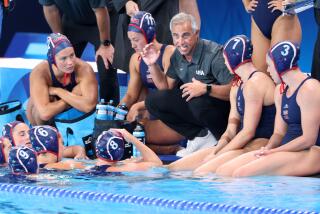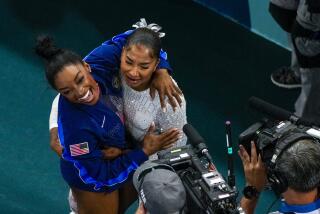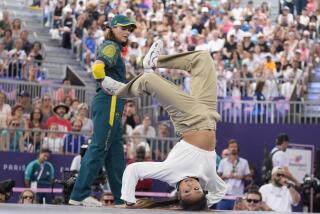Olympic Obstacles Were No Match for Karolyi
The gym is quiet, dark. Mats are piled every which way on the floor and a book sits forgotten on a table, its owner finished with classes for the summer.
Bela Karolyi sees none of this. He sees and hears what is not there. To him, this airless gym in the John Wooden Center at UCLA is a scene of happy chaos, of high-pitched laughter and bodies hurtling through the air.
Just down the corridor is the window through which he crawled to enter the gym and work with Mary Lou Retton and Julianne McNamara during the 1984 Olympics. Returning a few weeks ago, for the first time, it seems to him that nothing has changed, that the bouncy Retton and the meticulous McNamara might come through the door any minute, young and eager for him to mold them into Olympic champions.
“Oh, my gosh. It’s amazing,” he said, his eyes devouring the room. “This is the same, the short runway. It was such a controversy because it was shorter than it was supposed to be. It was no problem for Mary Lou, but Julianne was slower and had to have a long runway.
“Mary Lou, she ran like dum-dum-dum,” he added, miming heavy, decisive strides. “I can hear it, such powerful running. Such a pounding in her running. Julianne, when she was running, you barely could hear it.”
In 1984, Karolyi’s name elicited barely a nod of recognition in the United States. He had coached Nadia Comaneci in 1976 and 1980, but that wasn’t worth much when he and his wife, Martha, walked away from a 1981 Romanian gymnastics tour and sought a better life in the U.S. He worked menial jobs around Los Angeles before connecting with an old gymnastics friend, Paul Ziert, who steered him toward a coaching job in Oklahoma. He went into the gym business with a Houston group but was forced to run it himself when the group pulled out.
He did door-to-door advertising and relied on word of mouth to draw kids from neighboring subdivisions until he attracted a group that won a state title. His first major success was Dianne Durham, who’d won U.S. junior titles before joining him but became national champion under his tutelage in 1983. Her success drew Retton and, later, many others, but in 1984 he had little sway on the U.S. scene.
He had no official standing with the Olympic team because Don Peters of the SCATS club in Huntington Beach was the official coach. But Karolyi had no intention of abandoning Retton and McNamara.
“I did not even accept this idea, to turn them loose at the most important time,” he said.
Durham had been injured at the Olympic trials and wasn’t allowed to petition onto the team, so Karolyi accompanied McNamara and Retton to Los Angeles. Before the Olympic village opened, the gymnasts were housed at the distinctive, cylindrical Holiday Inn near the Sunset Boulevard exit of the San Diego Freeway. He wasn’t allowed inside, so he slept in the parking lot, in a car that belonged to fellow Romanian Karel Stabisevsky, who played piano for the gymnasts’ compulsory exercises.
“A compact car,” he said. “I believe it was a Chevette.”
He’d stand atop the dumpster outside the hotel and shout to Retton on her balcony high above, urging her to rest and share with McNamara details of their practice schedule.
“She’d say, ‘Bela, I can barely see you,’ ” Karolyi said, looking almost fondly at the dumpster during a recent visit to his Olympic landmarks.
“For me, I could visit them and see them and talk to them. I spent a lot of hours in the reception area, waiting while the kids were sleeping and eating, and I’d follow them to the workout place, which, at the time, was open.
“When the time came and they officially opened the Olympic village, my participation in workouts was limited. I had to stay outside and try to sneak in. I did sneak in at UCLA, through open windows and doors. But that was cut out when the village started receiving the foreign delegations and security was set up much higher. At that moment, I was lost. I was thinking, ‘What can I do?’ ”
The closest he could get was a parking garage. The sight of it stirred more memories, not all pleasant.
The time he spent there “was the hardest part,” he said. “Three days I was sitting in the parking lot. The police came one time and got me, probably close to midnight. They put a flashlight on my eyes and wanted to see my license and asked, ‘What are you doing here?’ I was out of language, No. 1, and, No. 2, I had no proper ID. I had a green card. He tried to get me to the security [office] across the little alley, but I told him, ‘Honestly, I have kids here and the car is not mine but I can use it.’ ”
He wasn’t arrested, but he wasn’t home free, either. Inspiration struck one day when he saw employees of the company that supplied and assembled the gymnastics equipment at Pauley Pavilion.
“I looked at one that was more approachable and said, ‘I have a little money, very little money, and if you can sell that thing from your neck for me, I would appreciate,’ ” Karolyi said, referring to the man’s credential. “He said, ‘What do you want to do with it?’ I said I wanted to get in because I got kids in there. He said, ‘Oh, you are the coach of Mary Lou and Julianne.’ But he said, ‘If I’m going to get caught, my life is over. But if I lost it and you find it ... ‘
“He put it down and I picked it up and I gave him $100, which I had in my hand, and the whole transaction was done. Of course, we were very different people. I had to ... do everything to look closer to what he looked like.
“I would sneak in with the girls every day. I would surround myself with the kids, talking very loudly, like we don’t want to be disturbed, and [guards] briefly look and say, ‘All right.’ After a couple of days they got used to the faces and there wasn’t any hard check-in any longer. But I would still be putting Mary Lou’s jacket on my back to look more like I belonged.”
He showered at UCLA and ate food meant for the gymnasts’ snacks.
“Mary Lou was the one coming with the goodies, the chicken tenders,” he said. “I’d say, ‘What meal today, Mary Lou?’ ”
His carefully crafted plan went awry, though, when the compulsory exercises were over and Stabisevsky took the car back.
“My housing was gone,” he said.
He couldn’t get a room, “because I had no money at the time, and you could not find a room. And I had to stay as much as I can around there. I had to be sure they were following their program. Pretty much all day, I would hang out at the gate at UCLA with the security guards....
“I said, ‘Why, why, why do I have to go through this?’ ”
Yet, he made do, and so did his gymnasts. Twenty years later, strolling down the same paths he’d sneaked along, he smiled as he pointed out the gate where he’d waited and at the Ackerman Union, which was used for fencing and other sports. He stopped when he saw the Janss Steps, where the gymnasts ran for conditioning.
“People said, ‘That’s crazy. They’re going to die,’ ” he said, smiling, “and they became Olympic champions.”
But the practice gym at the Wooden Center stirred the most memories. The uneven bars jogged his memory about Retton’s struggles on the new, stiff bars during training sessions at Pauley Pavilion.
“For Mary Lou, it was hard to adjust because she was stocky and heavy,” he said. “I was really, really, really very worried at that time because it wasn’t even close. Julianne, that one was lightweight and she was flying. She had long legs and arms, and for her it fit like a glove. That’s why she won gold [in the event final]....
“We didn’t want to go out there for the other people to see how struggling we are. One afternoon, there was official training, and we were training with the Soviets at the time. I pulled Mary Lou from the bars ... and we came here that same evening and worked on the difficulty she was facing with the rigid bars. It started every day to come a little bit more. Finally it got in pretty good shape.”
Good enough for her to win an individual bronze medal on the bars to go with her gold in the all-around, silver on vault and bronze in floor exercise. McNamara won gold on the bars and silver in floor exercise; Kathy Johnson of SCATS was the other U.S. individual medalist, winning bronze on the balance beam.
While Karolyi mused about 1984, UCLA women’s gymnastics coach, Valorie Kondos Field, entered the gym and shared her memories of the Games. Then a student and assistant coach, she always reminds her athletes they’re on honored ground.
“I would never want to build another gym out here because of the history,” she said.
It’s living history to Karolyi.
“It’s amazing,” he said, for probably the 30th time that day. “I’m not sure I would do it again, but that time I did, and I’m glad I did it.”
More to Read
Go beyond the scoreboard
Get the latest on L.A.'s teams in the daily Sports Report newsletter.
You may occasionally receive promotional content from the Los Angeles Times.







